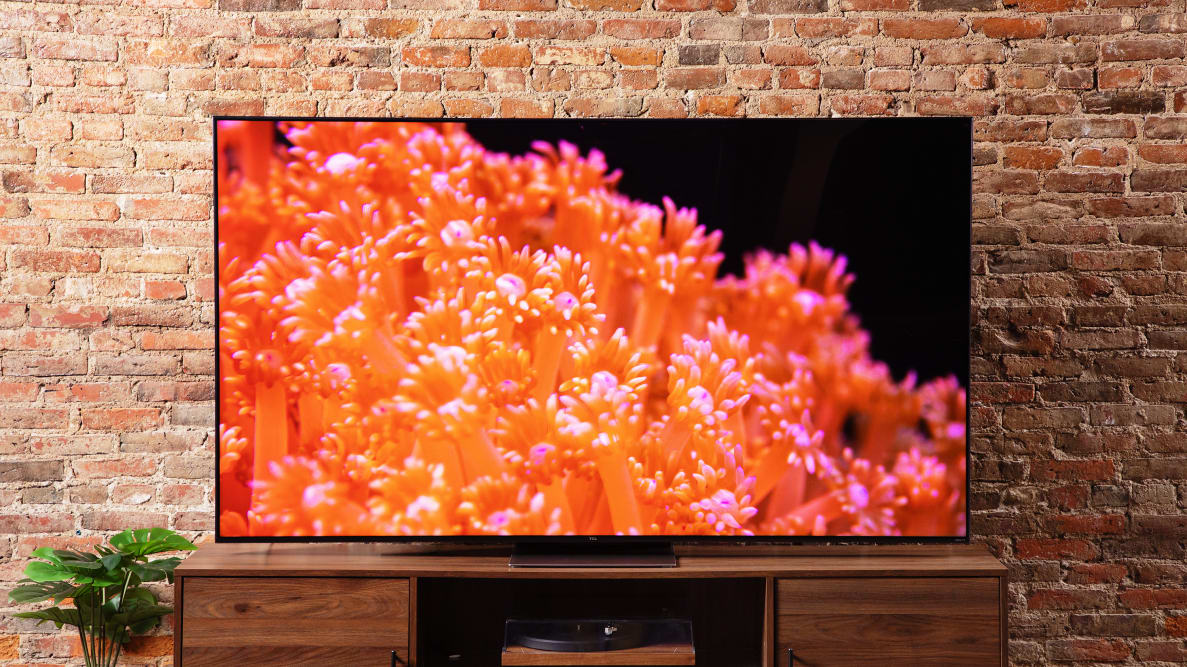Pros
-
Bright, colorful picture
-
Built-in Roku smart features
-
Class-leading gaming features
Cons
-
Not enough A/V customization settings
-
Out-of-the-box picture is too cool
-
Chunky, ho-hum design
Updated December 21, 2022: TCL has released an 85-inch version of the 6-Series for $1,999.99 which we have added to the About section.
For significantly less than what you’d pay for TVs with similar hardware, the TCL 6-Series offers a bright, colorful picture that holds up during sunny, daytime viewing. Its gaming features are abundant and well-thought-out, and its Roku software is perfect for casual viewers who might balk at busier, more-complicated smart platforms.
But its most accurate picture mode is tinted blue, and there’s not much to be done about it due to a more limited toolbox than what you get from competitors. If you want to feel a sense of true ownership over how your TV looks and sounds, the 6-Series might not be flexible enough for you. However, if you don’t intend on tinkering with your TV’s settings, the 6-Series is a great choice. Simply unbox it, set it up, and enjoy a bright, good-looking picture.
About the TCL 6-Series
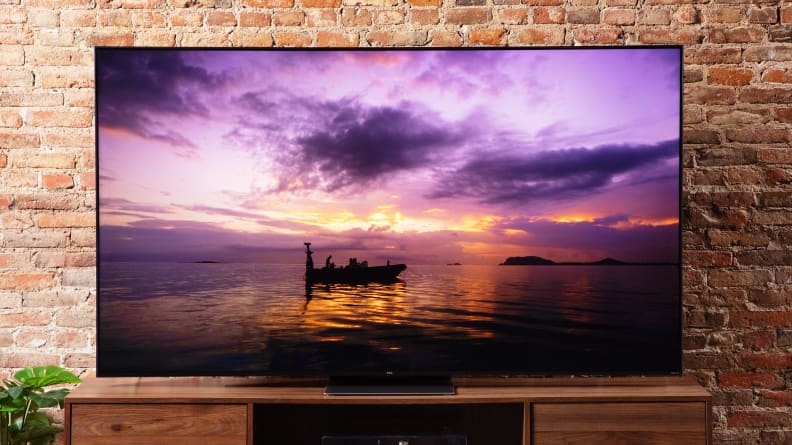
The 6-Series is available in three sizes, the largest of which is a 75-inch model.
The TCL 6-Series is available in three sizes. Our review unit is a 75-inch version that we received on loan from TCL. Here’s how the series shakes out in terms of pricing:
- 55-inch (TCL 55R655), MSRP $699.99
- 65-inch (TCL 65R655), MSRP $999.99
- 75-inch (TCL 75R655), MSRP $1,599.99
- 85-inch (TCL 85R655), MSRP $1,999.99
While we don’t expect there to be major differences in performance between these sizes, typically, each size variant of a mini-LED TV series features a different amount of dimming zones. The number of zones tends to increase proportionally to a TV’s size. A difference in zone count could spell slight differences in how a TV’s contrast performs.
TCL has disclosed that the 6-Series features “up to 360” local dimming zones, so it stands to reason that the largest size in the series, the 75-inch model, features 360 local dimming zones.
With sizing and pricing out of the way, let’s take a look at the 6-Series’ specs:
- Resolution: 4K (3,840 x 2,160)
- Display type: Mini-LED with local dimming and quantum dots
- HDR support: Dolby Vision, HDR10+, HDR10, HLG
- Dolby Atmos: Yes (native decoding)
- eARC support: Yes (HDMI 4)
- Native refresh rate: 120Hz (up to 144Hz VRR)
- Smart platform: Roku OS
- Color: DCI-P3 color space/10-bit chroma resolution
- Variable Refresh Rate (VRR): Yes
- Auto Low Latency Mode (ALLM): Yes
- Processor: AiPQ Engine
- Other features: AMD FreeSync Premium Pro, Apple AirPlay, Apple HomeKit, Amazon Alexa, Google Assistant
In the box, you’ll find the newest iteration of the Roku remote control. It’s very similar to the remote control included with Roku streaming devices. The remote features a built-in microphone for voice recognition and a handful of dedicated app buttons.
Connectivity
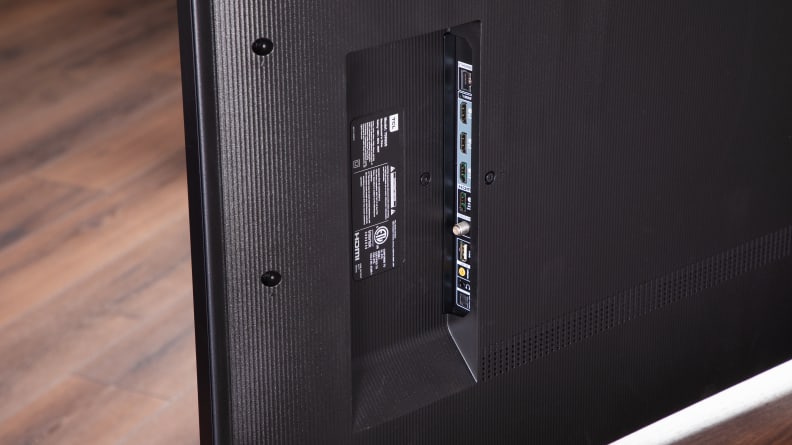
The 6-Series is ready for next-gen gaming on the Xbox Series X and PlayStation 5. Two of its HDMI ports support 4K gaming at 120Hz.
The 6-Series is ready to make the most out of your next-gen game consoles. Here’s what you’ll find in a cutout on the back of the TV’s panel:
- 2x HDMI 2.1 (4K @ 120Hz, up to 144Hz with VRR)
- 2x HDMI 2.0 (4K @ 60Hz, 1x HDMI ARC/eARC)
- 1x USB 2.0
- RF connection (cable/antenna)
- Ethernet (LAN) input
- Digital audio output (optical)
- Composite video + L&R audio in (mini 3.5mm connector)
- 3.5mm audio jack
Performance Data
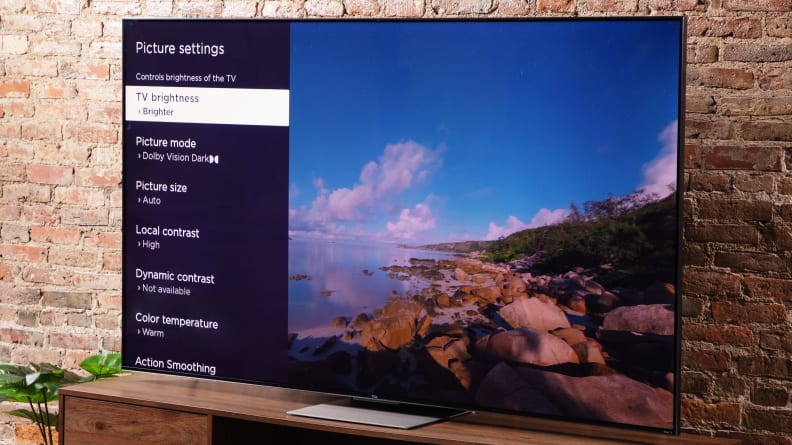
In order to make the most of the 6-Series' mini-LED backlight, we recommend setting Local Contrast to High.
Before testing each TV, we make sure the panel is on and receiving a continuous signal for at least 2 hours. Our 75-inch 6-Series received this standard warm-up time before any readings were taken. In addition, the TV received the latest firmware updates at the time of testing.
For SDR tests, we’re using the 6-Series’ Movie picture mode. For HDR tests, we’re using the TV’s Dark picture mode. We’ve chosen these settings because of their accuracy, but performance may vary depending on which picture mode is enabled. For example, you might experience a brighter picture with a different mode enabled, but it may negatively affect color temperature and overall color accuracy.
For additional context, I also ran some tests in alternative picture modes, but those results are not reported below.
To get a sense of the TV’s average performance, we use a standard ANSI checkerboard pattern for most of our basic contrast tests. We also use white and black windows ranging from 2% to 90% to test how well the contrast holds up while displaying varying degrees of brightness.
Our peak brightness measurements are taken with sustained windows to represent the TV’s peak brightness over a sustained period of time. Specular highlights (like brief flashes of reflected light) might reach higher brightness levels, but not for sustained periods of time.
All of our tests are created with a Murideo Seven 8K signal generator and tabulated via Portrait Displays’ Calman Ultimate color calibration software.
I'll expand on our test results throughout the review, but for now, here are some key takeaways:
- HDR contrast (brightness/black level): 751.4 nits/0.1 nits (ANSI checkerboard)
- SDR contrast (brightness/black level): 738.2 nits/0.074 nits (ANSI checkerboard)
- HDR peak brightness (sustained): 1,315 nits (20% white window)
- HDR color gamut coverage (DCI-P3/10-bit): 92%
- SDR color gamut coverage (Rec.709): 98%
These tests were carried out with Local Contrast set to High, Color Temperature set to Warm, and the following settings disabled: Action Smoothing, Action Clarity, and LED Motion Clarity. In addition, the TV Brightness setting was set to Brighter, and I pushed the 6-Series’ Backlight slider up to 100 for most of the SDR contrast tests to get a sense of the upper limit of its brightness during most content.
While you won’t find a gamma setting in the TV’s picture menu, you can access it—along with a handful of additional picture settings—in the official Roku mobile app. From here, I was able to confirm that the 6-Series’ gamma was set to 2.2.
What we like
Its bright, colorful picture looks great—even in a sunny room
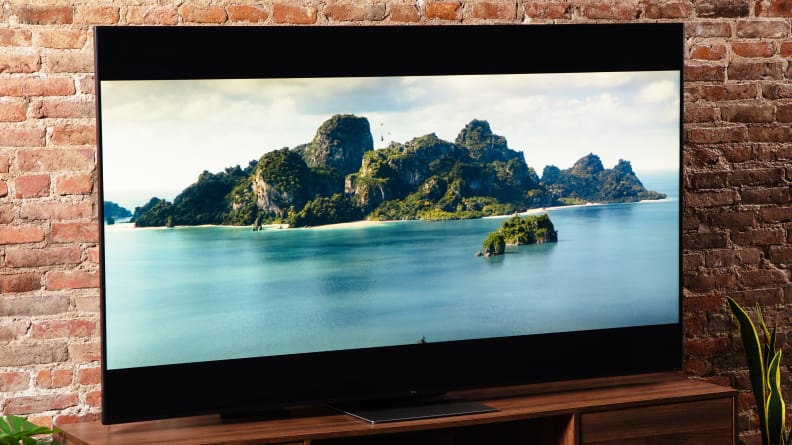
The 6-Series can crack 1,000 nits in HDR. Its impressive full-screen brightness will keep the action clear—even in sunny living rooms.
The TCL 6-Series is equipped with an impressive array of hardware for a TV in its class. Its ability to get brighter than most entry-level and midrange TVs has two primary benefits: The picture will hold up during daytime viewing and highlights during HDR content will properly pop.
Interestingly, the 6-Series’ average picture brightness is about the same in HDR as it is in SDR. In other words, a cable TV show broadcast in SDR will look about as bright as an HDR show streamed via Netflix. When measuring the TV’s contrast using a checkerboard pattern designed to display an equal amount of bright and dark picture elements, the brighter elements clocked in at around 738 nits in SDR and 751 nits in HDR. It manages to get this bright while still producing relatively deep black levels: about 0.05 to 0.1 nits. It’s not as inky as the Samsung QN90B (which dips as low as 0.025 nits), but it offers better black levels than the Sony X95K (which usually settles in the 0.1- to 0.2-nit range).
The 6-Series’ picture processing handles 4K/HDR content splendidly. Specular highlights (small, high-intensity areas of brightness) really pop, as the 6-Series is quite adept at driving a ton of brightness when displaying things like beaming reflections and fiery explosions. While watching Our Planet in Dolby Vision, I marveled at the sparkling, sun-dappled water reflecting off the backs of penguins and whales.
Consider this: In HDR, when measuring a small, white window that takes up 10% of the display, the 6-Series produced a result of 1,122 nits. With that same HDR pattern on the screen, the Sony X95K—a far more expensive TV—produced a result of 910 nits. That’s pretty impressive.
To be fair, the Samsung QN90B’s mini-LED display is capable of doubling this number with a 10% white window (2,472 nits). Nevertheless, I’m impressed by the 6-Series’ performance chops when it comes to peak HDR brightness.
Its sheer brightness isn’t the only thing that left an impression, either; the 6-Series’ local dimming is among the best I’ve seen on a mini-LED TV this year. It rivals the QN90B in its ability to limit light bloom whenever a bright object is moving against a dark background. I tested a number of subtitle styles to get a sense of how much bright, white text would affect the picture, and I’m pleased to report minimal haloing. There was some lifting of the black letterboxes at the top and bottom of the display, but not as much as I saw on the Sony X95K during similar sequences.
Thanks to its quantum-dot display, the 6-Series’ also produces rich, voluminous color on par with its competition. It covers about 92% of the HDR color gamut (DCI-P3), and while its colors aren’t as exquisite as, say, a quantum-dot OLED that’s three times the cost, its hues look better than most TVs in the mid-range class.
Reliably wide viewing angle
Although its viewing angles aren’t nearly as accommodating as an OLED TV’s, the 6-Series delivers wider-than-average viewing angles for an LED TV in this price range.
There’s a dip in contrast and color saturation when viewed from an off-axis position, but the minor color shift is more perceptible than the dip in contrast. If you’re shopping for a 65- or 75-inch model with the hopes of hosting movie night, the 6-Series will prove a pretty trusty companion.
It’s a proper gaming TV
The 6-Series is about as good as a gaming TV can be in this price range. You’re not getting four high-bandwidth HDMI 2.1 ports for maximum gaming potential, but its gaming features are generous and well-thought-out.
In addition to supporting Auto Low Latency Mode and standard Variable Refresh Rate, the 6-Series also invited AMD FreeSync Premium Pro to the party, ensuring that supported games on the Xbox or your AMD PC will run smoothly, free of visual artifacts like screen tearing. (The PS5 doesn’t support FreeSync.) Two of its HDMI ports support 4K gaming at 120Hz, and crucially, the TV’s eARC-enabled HDMI port does not pull double-duty as a high-bandwidth gaming port.
Those two high-bandwidth HDMI 2.1 ports also purport to deliver a 144Hz refresh rate when VRR is enabled. We’ve not yet tested the 6-Series’ reported 144Hz refresh rate during VRR-enabled gameplay, but we’ll update this review when we do.
Easy-to-use smart features with plenty of apps
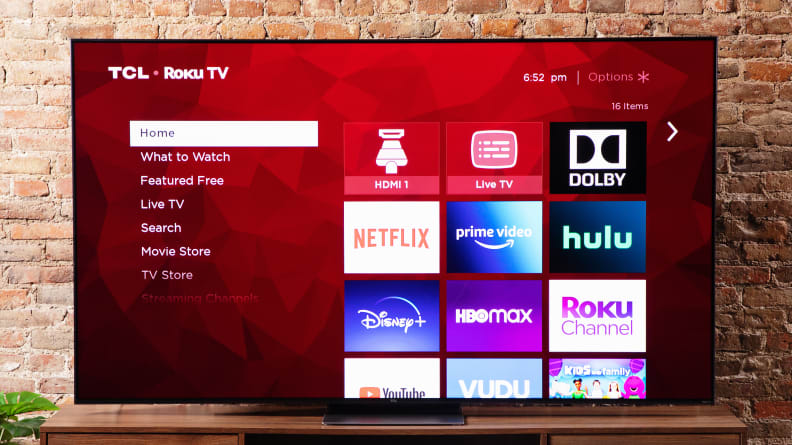
The TCL 6-Series is a Roku TV, so it has Roku's smart platform built right in. It's one of our favorite smart platforms on account of its easy navigation and limited ads.
If your ideal smart TV is one with plenty of app support, a clean, easily navigable layout, and as few ads as possible, the 6-Series is ready for all of your streaming endeavors.
The Roku experience is one of big, bold buttons and easily digestible, user-friendly language. It takes mere moments to familiarize yourself with the layout, and while most smart platforms dole out a heaping helping of sponsored content on the home screen, Roku keeps the ads to a minimum—there’s usually only one on the screen at a time.
But don’t let the big, colorful buttons fool you; Roku isn’t a Fisher Price smart platform. The Roku Channel store offers more apps than you can shake a clicker at. Plenty are pre-installed out of the box, and even more can be downloaded at the drop of a voice command.
In other words, Roku is a fantastic smart platform for both dedicated streamers and casual viewers looking for a straightforward, fuss-free experience.
What we don’t like
It’s not a TV for tinkerers
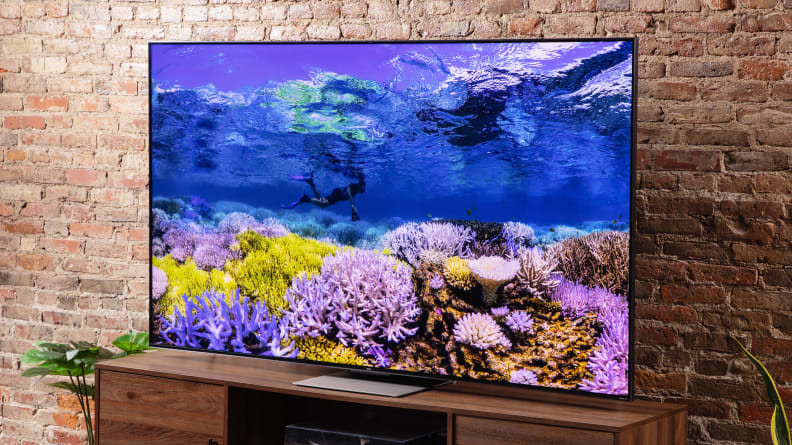
This year's 6-Series is the best one yet, but folks who want to adjust the picture to their liking might find the TV's lack of customization options limiting.
It had been a while since I’d taken a Roku TV out for a spin, and as much as I was excited to live inside its zippy, easy-to-navigate smart platform, I had forgotten how limiting it can feel for someone who knows how to get their hands dirty inside the settings menu. The 6-Series offers very little in the way of A/V customization options, and in order to fully look under its hood, you need to download the official Roku mobile app and make those adjustments from your smartphone or tablet.
This might sound fine if you intend on downloading the app anyway. In fairness, plenty of folks might find the app useful—its private listening feature is great for shared living spaces, for instance. But there aren’t many options in the app’s Expert Picture Settings menu to begin with, and the ones that are useful to mess around with (Gamma and Noise Reduction, for example) ought to be accessible via the TV’s software.
To make matters worse, I was unable to access the app’s Expert Picture Settings submenu while the 6-Series was streaming content. It worked as intended whenever I was tuned into one of the TV’s HDMI inputs, but Netflix, Prime Video, and YouTube were a no-go. A message in the app informed me that changing the expert settings “requires the Roku device to have a physical input selected or an active video stream,” so either my definition of “an active video stream” is completely different from TCL’s, or the feature isn’t working properly.
I tried tricking the app by making adjustments to the Expert Picture Settings menu while the TV was parked on HDMI Input 1, then jumping back to the TV’s Netflix app. Not only did the app boot me out of the Expert Picture Settings immediately upon switching to Netflix, but before it disappeared from my phone’s display, I noticed my settings reverting back to where they were before I made any adjustments. This is a massive bummer, as I would have liked to have seen how the TV’s noise reduction software looks while streaming 1080p content.
It’s not just the app that’s lacking: The 6-Series is likely to disappoint anyone who appreciates even a moderate amount of audio- and video-related customization options. There’s just not much here to tweak unless you’re happy mixing and matching color temperatures and picture modes.
That the 6-Series is a competent performer to begin with earns itself some good grace; I’d surely lament the lack of settings even more if the TV was sporting a bad picture. And for most folks, the 6-Series will look plenty good once they’ve chosen a picture mode that looks good to them.
If you’re not a set-it-and-forget-it kind of person, though, and your hands can’t help but fiddle with knobs, you might come away from the 6-Series feeling like one hand is tied behind your back.
Too cool for school
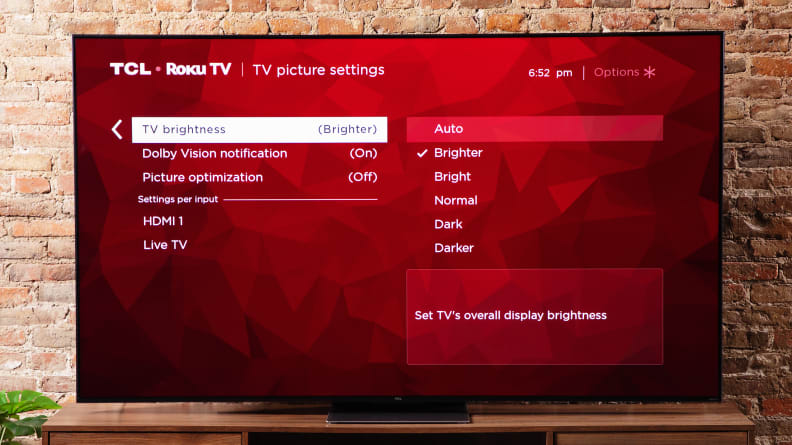
Adjusting the picture's overall brightness is one of the few adjustments you can make using the 6-Series' menu software. We found that all of its color temperature presets were cooler than they ought to be.
Even in its warmest picture mode with the warmest color temperature setting chosen, the 6-Series’ picture is quite cool. Neutral tones (gray, near-black, and white) all look bluer than they ought to, which has a pretty sizable impact on the TV’s picture.
To be fair, it’s far more noticeable when comparing the 6-Series side by side with a more-accurate TV than if you’re just tuning into your favorite show. That said, you won’t be able to alleviate this issue without an in-depth calibration—a tough ask, given that the 6-Series’ color management system is relegated to the Roku mobile app. It’s also not something we generally recommend spending the extra money on for mid-range TVs.
It’s not the swankiest-looking mini-LED TV on the block
The 6-Series might be able to go toe-to-toe with some of the higher-end mini-LED TVs when the lights are off, but in the harsh light of day, you might detect a faint air of parsimoniousness when inspecting some of TCL’s design choices.
The chassis is relatively chunky compared to the super-slim Samsung QN90B, and its plain, black plastic feels far less sturdy than the materials wrapped around the back of the X95K. To be fair, both of those mini-LED TVs are substantially more expensive than the 6-Series, but I do wish the 6-Series featured a slimmer, more stylish look. Even the Hisense U6H (which is priced significantly less than the 6-Series) sports a more premium look and feel.
And while it’s nice to have basic cable management and two stand configurations to choose from (one of which is more conducive for soundbar placement), the flat, plastic stand certainly brings the budget vibes whenever you put your hands on it.
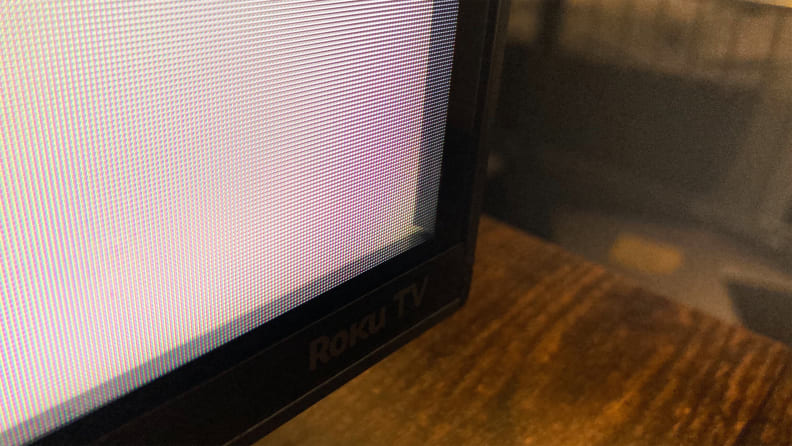
From certain angles, a border within the 6-Series display can be seen around the edges of the picture. This border often reflects light from the screen.
The 6-Series also shares a design quirk I first noticed on last year’s 8K 6-Series. There appears to be a slight, quarter-inch indentation behind the display’s glass that creates a border around the picture that’s most notable when viewing the TV from an off-axis position. Due to the materials used, this slight indentation reflects light, causing the picture to be flanked by a ghostly, flickering border.
Should you buy it?
Yes, especially if you’re a casual viewer looking to maximize your dollar
The TCL 6-Series delivers a heaping helping of value without compromising too much on performance or features. For several hundred dollars less than TVs like the Samsung QN90B and the Sony X95K, the 6-Series offers a similar experience: terrific brightness, great overall contrast, and a robust suite of next-gen gaming features. You might even find that it’s a more desirable gaming option than the X95K, as its eARC-enabled HDMI port doesn’t double as a potential gaming port.
For A/V enthusiasts and picture tweakers, the 6-Series is not a good TV for tinkering, apart from choosing a picture mode and fiddling with the backlight. But if you’re a set-it-and-forget-it type of viewer and don’t care about getting your hands dirty in the settings menu, the 6-Series is a terrific option. It’s bright enough for daytime viewing, its local dimming is seriously impressive, and its Roku software is easy to warm up to.
While we’ve yet to take the similarly priced Hisense U8H for a spin in our lab, the Hisense U6H—a more affordably priced TV—doesn’t get nearly as bright as the 6-Series. The Sony X80K, another TV in the 6-Series’ price range, uses less-sophisticated display hardware and isn’t cut out for next-gen gaming, either.
In a way, it’s somewhat strange to see a TV with premium hardware, premium gaming features, and almost no customization options to speak of. But if you’re hoping to save money on a gaming-ready TV that looks good right out of the box, the 6-Series—and its affordable price tag—are hard to beat.
Meet the tester
Michael Desjardin graduated from Emerson College after having studied media production and screenwriting. He specializes in tech for Reviewed, but also loves film criticism, weird ambient music, cooking, and food in general.
Checking our work.
Our team is here for one purpose: to help you buy the best stuff and love what you own. Our writers, editors, and lab technicians obsess over the products we cover to make sure you're confident and satisfied. Have a different opinion about something we recommend? Email us and we'll compare notes.
Shoot us an email
